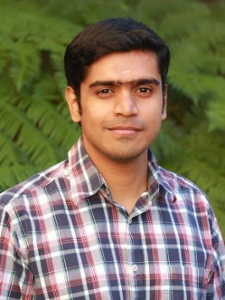OSE Seminar by Dr. Prasad P. Iyer on Active Control of Spontaneous Emission from Semiconductor Metasurfaces
Departmental News

Posted: October 3, 2023
Date: Thursday, October 5, 2023
Time: 12:45 PM Mountain Time (US and Canada)
Free Pizzas and Sodas
Location: CHTM, Room 103 and Zoom
Abstract:
The ability to achieve spatiotemporal control of incoherent (thermal and quantum) light emission has been a critical challenge in the field of optics with far ranging applications from remote sensing, holographic displays and quantum information processing. Here we present our results on ultrafast dynamic steering of spontaneous light emission from high-density InAs quantum dots (QDs) embedded inside GaAs resonators under structured optical pumping.
Spatially varying refractive index profiles is the key to steer incoherent light, since reconfigurable metasurfaces operating as phased-antenna arrays can only steer coherent (laser) light. We discover spatial refractive index profiles beyond human intuition that enable high efficiency (77%) steering of incoherent emission from reconfigurable dielectric metasurfaces over an 80° field of view, using generative models and active learning. We developed a machine learning framework where an active learning agent drives a generative model (variational autoencoder- VAE) to predict a spatially structured optical pump pattern which, when imaged onto the metasurface, generates a highly directional emission of incoherent light. This was achieved by creating a dynamic spatially varying resonant phase gradients across the metasurface using an ultrafast (80fs, 1 Khz rep rate, 3mJ/cm2) 800nm pump which images the pattern from a spatial light modulator (SLM) onto the metasurface. The photoluminescence (beam) steering is initially demonstrated using a periodic blaze (saw-tooth) grating patterns, which created a periodic refractive index profile using Drude free-carrier refraction, resulting in a spatial phase gradient on the metasurface and ultimately directing the momentum of the light emission. We find that AI-generated pump patterns are 10x more efficient in beam steering compared to the initial periodic blaze grating pump pattern designed using human intuition. Our work provides a novel machine learning driven closed-loop platform to understand and discover the physics of incoherent emission steering from metasurfaces with potential applications for augmented and virtual reality displays.
This work was performed, in part, at the Center for Integrated Nanotechnologies, an Office of Science User Facility operated for the U.S. Department of Energy. Sandia National Laboratories is a multi- mission laboratory managed and operated by National Technology and Engineering Solutions of Sandia, LLC., a wholly owned subsidiary of Honeywell International, Inc., for the U.S. Department of Energy’s National Nuclear Security Administration under contract DE-NA0003525. The views expressed in this article do not necessarily represent the views of the U.S. Department of Energy or the United States Government.
Biography:
Prasad Iyer is a staff scientist at the center for integrated nanotechnology (CINT) in Sandia National labs. Prasad got his PhD in electrical and computer engineering from the University of California Santa Barbara on reconfigurable optical metasurfaces. He later worked towards commercializing beam steering metasurfaces for Lidars at Lumotive, a Bill Gates funded startup in Seattle before joining Igal Brerner’s group at Sandia. Prasad has been a technical advisor for several metamaterial startups and currently leads numerous projects at Sandia and CINT at the intersection of AI-driven discovery of material science, fundamental light-matter interaction and efficient computation with light.
